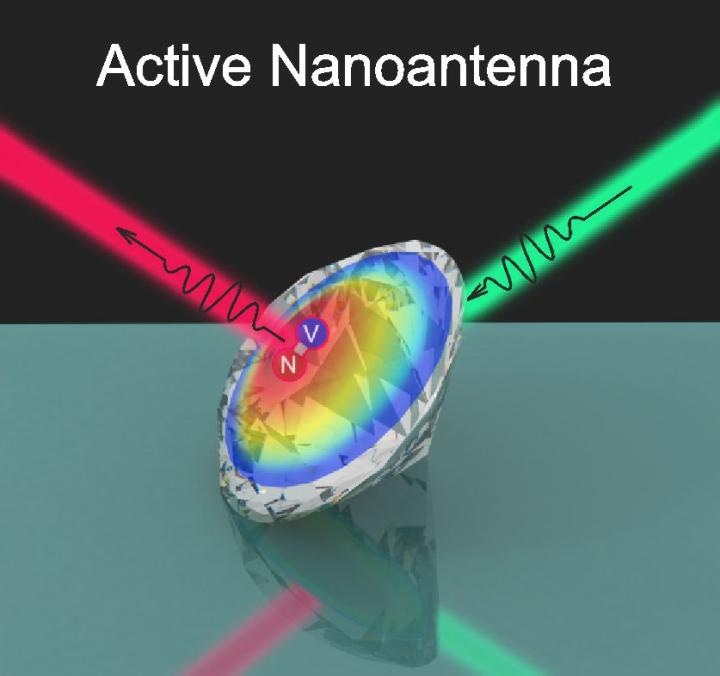May 3 2018
A research team from ITMO University has created a controlled light source based on nanodiamond for the first time ever. Experiments have demonstrated that diamond shell accelerates the emission speed light sources and helps to regulate them without any extra nano- and microstructures. This was accomplished because of artificially induced defects in a diamond crystal lattice.
The attained results are significant for the progress of quantum computers and optical networks. The research has been published in the Nanoscale.
 The scheme of obtained active nanodiamond antenna. (Image credit: ITMO University)
The scheme of obtained active nanodiamond antenna. (Image credit: ITMO University)
One of the main areas of advanced nanophotonics is the development of active dielectric nanoantennas or controlled photonic sources. Researchers typically use plasmonic metal nanoparticles as a base for nanoantennas. However, optical loss and heating of these particles prompt researchers to seek alternatives. For instance, ITMO University researchers keenly develop dielectric nanophotonics: they make nanoantennas based on silicon and perovskites. In recent times, members of International Laboratory for Nanophotonics and metamaterials of ITMO University created a new theory of active dielectric nanoantennas based on nanodiamonds.
Nanodiamonds can be defined as carbon nanostructures with novel properties. They have a high thermal conductivity, an adequately high refractive index, and low interaction activity. The researchers used nanodiamonds with so-called nitrogen-vacancy centers (NV-centers). They are formed artificially by taking out carbon atoms from the diamond crystal lattice. An opened vacancy is then connected to an implanted nitrogen atom. The electron spin of that kind of NV-center is easily manipulated by light, so that applying that electron spin one can record quantum information.
Researchers from ITMO University examined optical properties of nanodiamonds and discovered that their radiation can be improved by integrating the NV-center luminescence spectrum with optical Mie resonances of diamond nanoparticles. This can be realized at a specific position of the NV-center and the correct particle size. This way one can boost a nanodiamond Purcell factor. This indicator is used to estimate the way in which a diamond shell influences the rate of spontaneous emission of the light source. If the Purcell factor increases, the luminescence fading time decreases while the signal itself becomes robust and a lot easier to read.
The researchers highlight that this effect is realized by using solely properties of nanodiamonds.
Usually, to accelerate the radiation, one has to create a complex system of resonators. But we managed to achieve similar results without any additional structures. We showed experimentally that the luminescence fading can be speeded up at least two times, using just simple physics.
Dmitry Zuev, The International Laboratory for Nanophotonics and Metamaterials
Actually, experiments were performed on nanodiamonds with numerous NV-centers. The scientists also created a theoretical model for the behavior of single photon sources in the diamond shell. Calculations revealed that the speed of light emission can be boosted by several dozen times.
"Today getting a single photon from one NV-center in a nanoantenna is a rather difficult task. In order to implement such active nanoantenna in logic elements, for example, you need to manage their emission. In perspective, our concept will help to effectively manage single photon emission sources. It is very important for the development of quantum computers and optical communication networks," notes Anastasia Zalogina, the article’s lead author, a member of the International Laboratory for Nanophotonics and metamaterials.